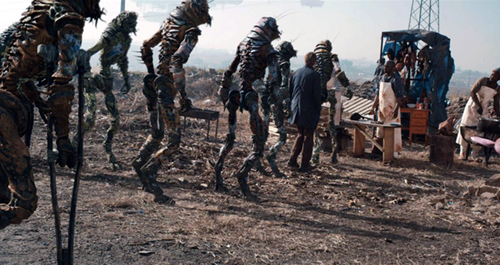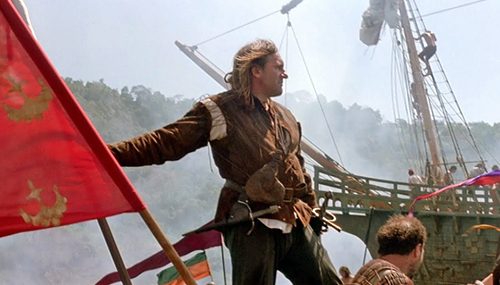Poster promoting the 1936 Berlin Olympics in England and America.
It’s amused me that Nazis placed the tall, blond, blue-eyed, square-jawed “Aryan” on a pedestal despite the fact that Hitler (and most Germans) didn’t fit the Aryan stereotype.
This memorandum describes two science fiction alternative history novels—one from 1974 and another from 1937—that dealt with the blond Aryan stereotype and Nazism.
This piece also touches on the roles for blond men on screen.
“Aryan” was originally just a language term.
It referred to the prehistoric peoples who spoke Indo-European languages, and “Indo-European” covers a big area, Europe, the Iranian plateau, and northern India.
During the 1850s, the term “Aryan” was “adapted” by French “thinker” Arthur de Gobineau (1816-1882) to refer to “white” Europeans (that is, Northern Europeans who weren’t Jewish).
Adolf Hitler, and the Nazis, fixed upon De Gobineau’s discredited theory that “whiter-skinned” Europeans were intrinsically “superior” to Southern Europeans (and the rest of the world population).
 The original cover for The Iron Dream illustrated its’ yellow-haired hero (shown above).
The original cover for The Iron Dream illustrated its’ yellow-haired hero (shown above).
Later editions showed Hitler on the cover, to clarify that The Iron Dream was a satire!
In 1974, Norman Spinrad spun the satirical science-fiction tale The Iron Dream.
(I’m told it was a big hit on college campuses.)
The Iron Dream contains a post-apocalyptic novel called “Lord of the Swastika” (written by an alternate-universe Adolf Hitler), along with an afterword by a fictional editor/historian called Homer Whipple.
The afterword is set on an Earth in which WWII was never fought, and in which Hitler immigrated to the U.S. (in 1919) and became a hack science-fiction illustrator/writer, in New York City.
According to the Iron Dream afterword, “Lord of the Swastika” was Hitler’s final work, written just before his death (in 1953) of causes probably related to syphilis.
In Whipple’s afterword—supposedly written five years after the Hitler novel was created (1958)—most of Europe and Africa (including Great Britain), had become the “Greater Soviet Union.”
The U.S. and Japan are tight allies, because only they hadn’t gone Communist.
Hitler’s novel, on the other hand, is set on a post-apocalyptic Earth in which a nuclear holocaust has made most humans mutants.
While a few settlements remain in which human-looking people predominate, most cities contain deformed mutants, plus another type of mutant (Dominators).
Like Professor X in the Marvel Universe, the Dominators are able to telepathically control others.
Their power is so frightening to “true humans” that Dominators are killed as soon as they’re identified.
The Earth is living in an uneasy truce.

Doc Savage, the 1930s pulp hero created by Lester Dent, was not an Aryan superman.
His eyes weren’t blue; they were light brown, flecked with gold.
A "hero" (named Fenric Jaggar) comes on the scene to claim his "birthright as a genotypically pure human"
(“Feric” is close to the German word for iron (ferric); “Jaggar” is similar to a word for warrior or hunter.)
Feric is described as “a tall, powerfully-built true human in the prime of manhood.
His hair was yellow, his skin was fair, his eyes were blue and brilliant.
His musculature, skeletal structure, and carriage were letter-perfect, and his trim blue tunic was clean and in good repair.”
(As you can see from this excerpt, Spinrad was trying his best to imitate the over-the-top writing style of a pulp writer.)
At first, Feric just wants to live in a “true human” society.
After he discovers that “true humans” are living in close proximity to mutants, he decides on genocide as the best solution.
As Feric builds a following, he uses visual symbols—flags, swastikas, and uniforms of “shiny black leather”—to manipulate the mass psyche.
These tools are just as important as his magic weapon (the “Great Truncheon of Held”) that he found in the Emerald Wood, and which only he is able to wield.
Feric gains power among “his people,” and begins a bloody World War against the Dominators and the rest of the lizard and parrot-people mutants.
In Whipple’s afterword, he decries the “nauseating violent excesses,” “blatant phallic symbolism,” and complete lack of female characters in “Lord of the Swastika.”
I didn’t enjoy the endless battle scenes, but I did enjoy the ending before the ending of The Iron Dream.
The ancient leader of the Dominator mutants faces off with Feric, and before the mutant dies, he’s able to push a button, and set off several nuclear bombs.
Feric survives, but he’s no longer a “genotypically pure human.”
Neither is anyone else born on the planet Earth.
(This wasn’t the actual ending of the novel, but I wish it was.)
(Control-click on the cover to enlarge to read the cover text)
Cover of Swastika Night. British author Katharine Burdekin used the pen name Murray Constantine.
Katharine Burdekin’s Swastika Night is a much better read, and (unlike The Iron Dream) rich in psychological insights.
This science-fiction tale also deals with the tall, blond, blue-eyed, square-jawed “Aryan” stereotype.
However, it was written in 1937, thirty-seven years before The Iron Dream was written, and the very year that WWII began.
Swastika Night is set on an alternate Earth more than 700 years after Germany and Japan have won WWII.
The two countries have split the world between them, and a main character is Alfred EW 10762, an ordinary-looking thirty-year-old airplane technician who’s traveled from subjugated Britain to visit the “Holy Places” in Germany, where long-dead Adolf Hitler is worshipped in the Nazi state religion.(There’s a sacred spot along the Rhine River where Hitler swam across.)
Englishman Alfred meets an elderly Nazi Knight named Frederick Van Hess (descended from Rudolf Hess).
(The ruling class doesn’t have numbers in their names.)
Van Hess has preserved a family manuscript for over 25 generations that reveals the long-hidden true history of the world.
This manuscript contains a real photograph of Adolf Hitler.
Alfred learns that Hitler was not a seven-foot-tall warrior with long golden hair, and a “noble rugged brow.”
Germans didn’t create civilization, and weren't always the “Master Race.”
One subject of Swastika Night is how Alfred deals with the discovery that everything he’s been taught since childhood is a lie.
In some ways, Swastika Night was a precursor to Margaret Atwood’s The Handmaid’s Tale.
Unlike Atwood’s vision, however, women aren’t split into two separate classes—“elevated wives” and “child-bearing women.”
Instead, in Burdekin’s Nazi society, all women are “kept in pens: their heads are shaved bald, they wear formless gray sacks, and their only purpose in life is to produce sons for their masters.”
Rosa Klebb (Lotta Lenya) and Grant (Robert Shaw) in the James Bond film From Russia with Love.
Since blond hair usually darkens with age—and only 2% of the world population has blond hair anyway—many actors have resorted to peroxide to represent the blond, blue-eyed “superman” on stage and screen.
Dark-haired English gentleman, Robert Shaw, dyed his hair blond to play the muscular villain (Grant) in From Russia with Love, and Panzer tank commander Col. Hessler in Battle of the Bulge.
Hamlet (Lawrence Olivier), with Yorick’s skull, in a photo released for the 1948 film Hamlet.
Actually, unless blond hair is matched with a muscular build, blond men aren’t always “supermen.”
According to theatre lore, Lawrence Olivier dyed his brown hair platinum blond so he could play the “archetype Dane” in Hamlet.
(As a result, other actors—especially younger actors in student productions—began to sport blond hair when playing “Hamlet.”)
Olivier believed that blond hair weakened the forcefulness of his appearance, and was better suited for the part.

Dr. Frank-N-Furter (Tim Curry) views his “Creation” (Peter Hinwood) with appreciation, in The Rocky Horror Picture Show.
I’m pretty sure that Peter Hinwood, the “Creation” in The Rocky Horror Picture Show (1975), was a natural blond.
However, he dyed his hair lighter for the role.
(His physical form was perfect, but his personality was a bit “wimpy” in Rocky Horror.)
Speaking of blond hair indicating weakness in a man, according to a 2011 study* brown hair in men is associated with being attractive, intelligent and competent, while blond hair in men is associated with being “needy.”
After all, isn’t it “tall, dark and handsome?” and not “tall, blond and handsome?”
*”British Men’s Hair Color Preferences: An Assessment of Courtship Solicitation and Stimulus Ratings,” V. Swami and S. Barrett, Scandinavian Journal of Psychology, Vol 52, 2011, December.


















































